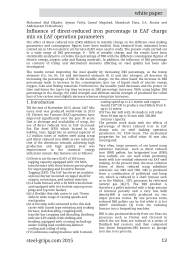The effect of direct reduced iron (DRI) addition in metallic charge on the different steel making parameters and consumption figures have been studied. Data obtained from industrial heats carried out in 185-ton electric arc furnace (EAF) were used to study. The present study carried out in a wide range of DRI percentage, 0 - 50% of metallic charge, and the results have been statistically analyzed to correlate the percentage of DRI with the different consumption figures of electric energy, oxygen, coke and fluxing materials. In addition, the influence of DRI percentage on contents of tramp and detrimental elements affecting on steel quality has been also investigated.
The results reveal improving the steel quality by increasing DRI percentage, as the tramp elements (Cu, Sn, Ni, Cr) and detrimental elements (P, S) and also nitrogen, all decrease by increasing the percentage of DRI in the metallic charge. On the other hand, the increase in DRI percentage leads to increase in the consumptions (per ton of liquid steel) of electric energy, oxygen, coke and fluxing materials. Furthermore, the metallic yield decreases and the power on time and hence the tap-to-tap time increase as DRI percentage increases. With using higher DRI percentage in the charge, the yield strength and ultimate tensile strength of produced hot rolled bars of low carbon steel slightly decrease whereas elongation increases.
Influence of direct-reduced iron percentage in EAF charge mix on EAF operation parameters

